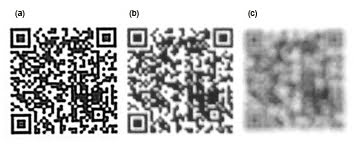Using Wavefront Coding, camera phones can deliver true point-and-shoot capability.
Ed Dowski and Kenny Kubala, CDM Optics
Some mobile phone camera users want a device with true point-and-shoot ability — a camera that captures high-quality images over a wide variety of object distances with no time delay. Whether shooting panoramas, portraits or close-ups, or even imaging business cards or bar codes, these users want images to be captured instantly, to be in focus and to have high image quality.
Using Wavefront Coding, a technology developed by CDM Optics, a division of OmniVision Technologies Inc. of Boulder, Colo., camera phones now can deliver true point and shoot over a wide range of scene illumination. TrueFocus, a new camera system employing this technology, will be available soon for mobile phones. The technology combines special optics and signal processing to produce images with increased depth of field without sacrificing light-gathering capabilities.
The close relationship between the optics- (encoding) and image-processing (decoding) elements enables digital cameras to capture sharp and clear images throughout the object field without physically moving optics to focus.

Figure 1. After image capture with a CMOS sensor, an image signal processor (in the center) removes the blur and produces a final image. The optics requires no more components than classical optics, and the signal processor can be very compact.
The special optics include fixed-focus ones that produce a specially blurred image over a large depth of field. After a sensor captures the blurred image, a signal processor removes the blur and produces the final image. The optics and image signal processor are designed to reduce the amount of silicon required by other common image signal processors. Compared with common mobile phone optics, the optics require no additional elements or cost and can, in fact, offer more favorable characteristics, including improved tolerances that can result in higher yields (Figure 1). Images are sharp and clear, with vibrant colors that rival the image quality of a digital still camera (Figure 2).

Figure 2. In a typical outdoor scene, the edges are crisp and clear, with no color artifacts.
In some parts of the world, especially in Japan, camera phones are used for taking images of business cards and bar codes so as to store the information, and the TrueFocus technology can simplify this procedure. By having a large depth of field, these imagers allow a large working range when imaging close objects. Although autofocus systems can adjust their focus over a large range, the depth of field at close range is necessarily very small, making it a challenge to get good images of close objects, such as business cards. The business card must be held square to the sensor so that its edges are not out of focus. Movement of the card after best focus is acquired also could cause the entire object to become blurry and unreadable. By comparison, it is easier to acquire images of business cards and bar codes with a camera using the TrueFocus system over a wide range of object distances. Tip-tilt of the cards is not noticed and does not cause image degradation.
Extending the depth of field
There are four methods that enable the extension of depth-of-field systems: capturing the 4-D light field, modifying the system through time, modifying the optical amplitude and modifying the optical phase. Each has a trade-off.
A system that captures a 4-D light field uses spatial redundancy to determine both the amplitude and phase of light rays incident on a given region of a detector. Allowing that there is a fixed amount of information that a sensor can capture, 4-D light-field systems sacrifice spatial resolution to gain depth information.1
Systems that use time to extend the depth of field mechanically change focus over the duration of an exposure2 or between exposures, as is done in confocal microscopy. Because of the increased image capture time and complexity, these systems are not practical in handheld devices.
Historically, depth of field was increased by decreasing the size of the aperture, which falls into the category of modifying the optical amplitude. There are other methods involving more complicated amplitude masks that result in extending the depth of field.3 The primary trade-off with these methods is a decrease in low-light performance.

Figure 3. These images are of a two-dimensional QR (quick response) bar code taken with a TrueFocus imager (a) and with a commercially available fixed-focus system in macro mode (b) and in far mode (c). The TrueFocus image is sharp and clear and easily decoded by common decode software over a wide range of object distances. The images from the fixed-focus system, in both mechanical macro and far mode, are blurred to the point where they cannot be decoded.
The final method involves modifying the optical phase, the category in which TrueFocus falls. Systems of this type are designed to balance imaging performance from distant to near by slightly modifying the optical system to give it different focusing properties. The fundamental trade-off is a decrease in modulation when compared with a traditional fixed-focus system at best focus and an increase in modulation away from best focus. Unlike other techniques, the loss of modulation can be mitigated by using faster optical systems. In mobile phone optics, the quadratic increase in signal with a faster optical module can compensate for the linear decrease in depth of field, with an additional margin that can be used for improved depth of field or low-light performance.

Figure 4. In a typical indoor scene, not having to focus, even in low light, means that shots can be captured as they happen.
Although, in some special applications, increased image capture times and decreased spatial resolution and low-light performance may be favorable, they are not well suited for the mobile imaging market, where the consumer values usability more than many other camera characteristics. This technology enhances imaging performance while enabling instant image capture, delivering full-resolution images and retaining good low-light performance.
Meet the authors
Ed Dowski is president and Kenny Kubala is the director of strategic technology at CDM Optics, a division of OmniVision Technologies Inc. in Boulder, Colo.; e-mail: [email protected], or [email protected].
References
1. R. Ng et al (April 2005). Light field photography with a hand-held plenoptic camera. Stanford University Tech Report. pp. 1-11.
2. Gerd Häusler (September 1972). A method to increase the depth of focus by two step image processing. OPT COMM, Vol. 6, pp. 38-42.
3. A. Veeraraghavan et al (2007). Dappled photography: Mask enhanced cameras for heterodyned light fields and coded aperture refocusing. ACM Transactions on Graphics, PROC SIGGRAPH, Article 69.